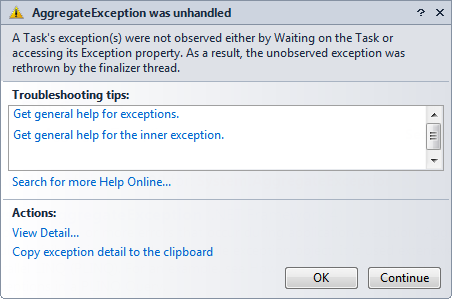在 .Net 开发中, 使用 Task 、 Task<T> 进行异步编程是非常方便的, 但是在处理 Task 产生的异常时, 需要注意一个问题, 比如下面的代码:
|
1
2
3
4
5
6
7
8
9
10
11
12
|
static Task<int> TestAsync(int a, int b) { var tcs = new TaskCompletionSource<int>(); Task.Factory.StartNew(() => { if (a + b < 0) { tcs.TrySetException(new InvalidOperationException("a + b < 0")); } else { tcs.TrySetResult(a + b); } }); return tcs.Task;} |
当输入的两个参数之和小于 0 时, tcs 会设置一个 InvalidOperationException , 如果直接运行这段代码, 当这个函数返回的 Task 被 GC 回收时, 将会产生 AggregateException was unhandled 的异常, 运行代码如下:
|
1
2
3
4
5
6
7
8
9
10
|
static void Main(string[] args) { TestAsync(5, -10); Thread.Sleep(TimeSpan.FromMilliseconds(3000)); GC.Collect(); Console.WriteLine("Completed.");} |
当程序运行结束时, 会产生下图所示的异常:

关键的是这段文字:
A Task's exception(s) were not observed either by Waiting on the Task or accessing its Exception property. As a result, the unobserved exception was rethrown by the finalizer thread.
没有在等待 Task 完成时捕获其异常, 也没有读取 Task 的 Exception 属性, 结果导致异常被终结线程重新抛出。 也就是说, Task 异常有两种处理方式:
1、 调用 Task 的 Wait 方法时使用 try-catch 捕获异常:
|
1
2
3
4
5
6
7
|
var testTask = TestAsync(5, -10);try { testTask.Wait();}catch(Exception ex) { Console.WriteLine(ex);} |
2、 在 Task 的 ContinueWith 方法中读取 Task 的 Exception 属性:
|
1
2
3
4
5
6
7
8
9
|
var testTask = TestAsync(5, -10);testTask.ContinueWith(task => { if (task.IsFaulted) { Console.WriteLine(task.Exception.GetBaseException()); } else { Console.WriteLine(task.Result); }}); |
在 .Net 4.0 、 Sliverlight 5.0 、以及 MonoTouch 中均有类似的问题, 因此, 必须小心翼翼的处理 Task 产生的异常, 否则将会导致你的程序异常退出。